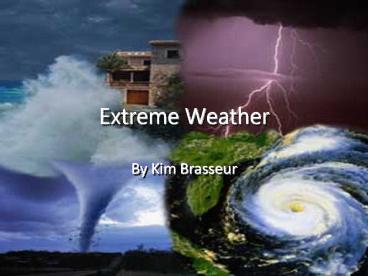Extreme Weather PowerPoint PPT Presentation
Title: Extreme Weather
1
Extreme Weather
- By Kim Brasseur
2
Types of Extreme Weather
- Tornadoes
- Hurricanes
- Thunder and Lightening
- Blizzards
- Floods
3
Tornadoes
- Tornadoes are the most powerful, unpredictable
and destructive weather system on earth. - A tornado is a violent rotating funnel-shaped
column of air extending from a thunderstorm to
the ground. - They can have wind speed up to 300 mph.
- Tornadoes happen where dry, cold air masses mix
with warm, moist air masses. - More tornadoes occur in the United States than in
any other country.
4
Hurricanes
- A huge storm that measures several hundred miles
in diameter - Hurricanes have two main parts
- First is the eye of the hurricane, which is a
calm area in the center of the storm. - second is the wall of the clouds that surrounds
the calm eye. This is where the hurricanes
strongest winds and heaviest rain occur. - Hurricanes rotate in a counter-clockwise
direction around the eye. - Hurricane winds can be 74 to 200 mph.
- Hurricanes are born over warm, tropical oceans.
- They are fueled by water vapor that is pushed up
from the warm ocean surface. - http//www.youtube.com/watch?vOEPZOC6YHUc
5
Thunder
- A thunderstorm is a storm with lightning and
thunder. - Thunder is caused by lightning.
- They are produced by a cumulonimbus cloud,
usually producing gusty winds and heavy rain, and
sometimes hail. - Thunderstorms are caused by rapidly rising and
falling currents of air. - When a lightning bolt travels from the cloud to
the ground it opens up a little hole in the air
called a channel. - Once then light is gone the air collapses back in
and creates a sound wave that we hear as thunder.
6
Lightning
- Lightning is a sudden, violent flash of
electricity between a cloud and the ground, or
from cloud to cloud. - A lightning flash, or bolt can be several miles
long. - Lightning is so hot, with a average temperature
of 34,00 degrees Centigrade, that the air around
it suddenly expands with a loud blast. This is
the thunder we hear. - Lightning occurs in hot, wet storms.
7
Blizzards
- A blizzards is a long-lasting snowstorm with
strong winds, intense snowfall, and cold
temperatures. - Winds of 35mph or greater, and little visibility.
- Three things are needed to have a blizzard cold
air at the surface, lots of moisture, and lift. - When a mass of polar air and warm air meet, the
polar air pushes the warm air up and settles in
the atmosphere where the water vapor forms snow
clouds. - The winds and low temperatures combine with the
snow to create a blizzard.
8
Flash Flood
- A flash flood is the fastest moving type of
flood. - They happen when heavy rain collects in a stream
or gully, turning the normally calm area into an
instant rushing current. - Flash floods appear and move quickly across the
land, with little warning that its coming. - Flash floods are generally a result of heavy
rainfall concentrated over one area. - Most flash flooding is caused by slow-moving
thunderstorms, thunderstorms that repeatedly move
over the same area, or heavy rains from
hurricanes and tropical storms. - Dam failure can also cause a bad flash flood.
When a dam breaks a gigantic amount of water is
suddenly loose downstream. - Flash floods move so fast they have the power to
tear out trees, destroy buildings, and break
bridges.
9
Sources
- Information
- http//www.livescience.com/environment/lightning_s
cience.html - http//weatherwizkids.com/index.htm
- http//fema.gov/kids
- http//wwwworldstory.net/en/tunder.html
- http//weathereye.kgan.com/expert/blizzard/wnstrom
s.html - http//www.theteachersguide.com/weather.html
- http//www.livescience.com/hurricanes/
- http//www.extremescience.com/weatherport.htm
- http//library.thinkquest.org/3805/events/Bliz.htm
10
Sources
- Pictures
- http//www.howtosurviveit.com/tornado-natural-disa
ster-400a061807.jpg - www.pntmc.org.nz/photos/Wanganui/pages/Flood_2.
html - ed101.bu.edu/.../mattwall/Extreme20Weather.htm
- www.flickr.com/photos/blackwolve/1471494190/
- https//www.novelmaker.com/index/genre_select...
- www.ehow.com/how_4027_prepare-home-hurricane.html
- www.sun-tek.com/ExtWthr.htm
- Remove frame
- www.topnews.in/regions/greece

